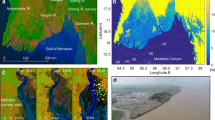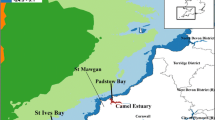Abstract
This article analyses the morphological history of the outer Thames seabed, covering over 3,000 km2 from Aldeburgh (Suffolk), to Southend-on-Sea (Essex) and Margate (Kent). The region has been depicted on bathymetric charts since the sixteenth century, and has been formally charted since the eighteenth century. Charts published since the early 1800s incorporate sufficient grid reference or ground control detail for georectification onto a common coordinate system (British National Grid). The morphological history of the outer seabed was thus reconstructed through the digitisation and interpolation of soundings onto a regular grid (3D surface). The evolution of seabed morphology was examined using transects, bathymetric change maps and spatial statistics. The results show considerable spatial variability in seabed behaviour. Within the central Thames, banks have experienced significant depth changes can be associated with lateral shifts in individual banks. Some of the outer banks in this region exhibit progressive elongation. Shifts in bank position across the Suffolk shoreface appear to be more subtle, and there is evidence here of both onshore and offshore migration. There is no clear evidence of any regionally coherent response to large-scale historical forcing such as sea-level rise.







Similar content being viewed by others
References
Burningham, H., 2008. Contrasting geomorphic response to structural control: the Loughros estuaries, northwest Ireland. Geomorphology 97: 300–320.
Burningham, H. & J. R. French, 2008. Historical Changes in the Seabed of the Greater Thames Estuary. The Crown Estate, London: 54.
Caston, G. F., 1979. Wreck marks: indicators of net sand transport. Marine Geology 33: 193–204.
Caston, G. F., 1981. Potential gain and loss of sand by some sand banks in the Southern Bight of the North Sea. Marine Geology 41: 239–250.
Cloet, R. L., 1954. Hydrographic analysis of the Goodwin Sands and the Brake Bank. The Geographical Journal 120(2): 203–215.
D’Olier, B., 1972. Subsidence and sea-level rise in the Thames Estuary. Philosophical Transactions of the Royal Society of London Series A. Mathematical and Physical Sciences 272(1221): 121–130.
Fitzgerald, D. M., I. V. Buynevich, M. S. Fenster & P. A. Mckinlay, 2000. Sand dynamics at the mouth of a rock-bound, tide-dominated estuary. Sedimentary Geology 131: 25–49.
Harris, P. T., 1988. Large-scale bedforms as indicators of mutually evasive sand transport and the sequential infilling of wide-mouthed estuaries. Sedimentary Geology 57: 273–298.
HR Wallingford, 2002. Southern North Sea Sediment Transport Study (Phase 2). HR Wallingford Report, EX 4526.
Jaffe, B. E., R. E. Smith & A. C. Foxgrover, 2007. Anthropogenic influence on sedimentation and intertidal mudflat change in San Pablo Bay, California: 1856–1983. Estuarine, Coastal and Shelf Science 73(1–2): 175–187.
Kemp, J. A. & A. Brampton, 2007. The development of a time trend analysis tool for GIS and its application in the assessment of Nash Bank, South Wales. Journal of Hydroinformatics 9(3): 193–201.
Langhorne, D. N., 1973. A sand wave field in the outer Thames estuary, Great Britain. Marine Geology 14(2): 129–143.
List, J. H., B. E. Jaffe, A. H. Sallenger & M. E. Hansen, 1997. Bathymetric comparisons adjacent to the Louisiana Barrier Islands: processes of large-scale change. Journal of Coastal Research 13(3): 670–678.
McCave, I. N., 1979. Tidal currents at the North Hinder lightship, southern North Sea: flow directions and turbulence in relation to maintenance of sand banks. Marine Geology 31: 101–114.
Park, H.-B. & C. E. Vincent, 2007. Evolution of Scroby Sands in the East Anglian coast, UK. Journal of Coastal Research SI 50: 868–873.
Prentice, J. E., I. R. Beg, C. Colleypriest, R. Kirby, P. J. C. Sutcliffe, M. R. Dobson, B. D’Olier, M. F. Elvines, T. I. Kilenyi, R. J. Maddrell & T. R. Phinn, 1968. Sediment transport in estuarine areas. Nature 218: 1207–1210.
Robinson, A. H. W., 1956. The submarine morphology of certain port approach channel systems. Journal of the Institute of Navigation 9: 20–46.
Robinson, A. H. W., 1960. Ebb-flood channel systems in sandy bays and estuaries. Geography 45: 183–199.
Robinson, A. H. W., 1980. Erosion and accretion along part of the Suffolk coast of East Anglia, England. Marine Geology 37(1–2): 133–146.
Stride, A. H., 1963. Current-swept sea floors near the southern half of Great Britain. Quarterly Journal of the Geological Society of London 119: 175–199.
van der Wal, D. & K. Pye, 2003. The use of historical bathymetric charts in a GIS to assess morphological change in estuaries. The Geographical Journal 169(1): 21–31.
van der Wal, D. & K. Pye, 2004. Patterns, rates and possible causes of saltmarsh erosion in the Greater Thames area (UK). Geomorphology 61: 373–391.
Woodworth, P. L., F. N. Teferle, R. M. Bingley, I. Shennan & S. D. P. Williams, 2009. Trends in UK mean sea level revisited. Geophysical Journal International 176: 19–30.
Wright, L. D., J. M. Coleman & B. G. Thom, 1975. Sediment transport and deposition in a macrotidal river channel: Ord River, Western Australia. In Cronin, L. E. (ed.), Estuarine Research 2. Academic Press, New York: 309–322.
Acknowledgments
The authors wish to thank the Crown Estate and the National Maritime Museum (Greenwich, UK) for ongoing support in this project. We are also very grateful to the interesting and helpful comments from the anonymous reviewers.
Author information
Authors and Affiliations
Corresponding author
Additional information
Guest editors: R. J. Uncles & S. B. Mitchell / The Thames Estuary and Estuaries of South East England
An erratum to this article can be found at http://dx.doi.org/10.1007/s10750-011-0873-3
Rights and permissions
About this article
Cite this article
Burningham, H., French, J. Seabed dynamics in a lage coastal embayment: 180 years of morphological change in the outer Thames estuary. Hydrobiologia 672, 105–119 (2011). https://doi.org/10.1007/s10750-011-0760-y
Published:
Issue Date:
DOI: https://doi.org/10.1007/s10750-011-0760-y




